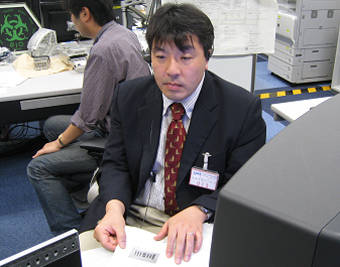This is an archive of information released in the past.
Disclaimer: It may contain broken links or outdated information. Some parts may not function in current web browsers.
*Visit https://humans-in-space.jaxa.jp/en/ for the latest information.

Experiment
- News
- Kibo Utilization Strategy
- Kibo Utilization Plan
- List of JAXA's Utilization Themes
- Experiment Facilities
- Space Environment Utilization
- Archive
Fish Scales Experiment Begins
* All times are Japan Standard Time (JST)
Investigation of the Osteoclastic and Osteoblastic Responses to Microgravity Using Goldfish Scales (Fish Scales)* began on board Kibo.
Prior to the experiment, Astronaut Noguchi unpacked and prepared the samples, and installed them into the Cell Biology Experiment Facility (CBEF) in the Kibo module.
*Principal Investigator (PI): Nobuo Suzuki, Associate Professor of Kanazawa University
Samples for the experiment were launched to the International Space Station (ISS) aboard the space shuttle Atlantis on the STS-132 mission on May 15, 2010.
Aboard the ISS, Astronaut Noguchi prepared the samples and placed them into the CBEF. The Fish Scales experiment began at 3:54 a.m. on May 17, 2010 by commands sent from the Tsukuba Space Center (TKSC).
Mammal bone is formed and or maintained by continuous remodeling through bone resorption by resorptive cells, or osteoclasts, and subsequent new bone formation by formative cells, or osteoblasts. However, the past biological studies indicated that bone loss and bone weakening occur in astronauts who participate in long-duration space missions.
It is assumed that osteogenetic cell deterioration and osteoclast activities cause decrease in bone mineral density, or bone loss. However, reasons of these space-induced deterioration and change in cell activities have not been clarified yet.
Fish Scales uses scales of goldfish as a bone model because fish scale has both osteoclast and osteoblast cells. To examine the mechanism of bone loss, the Fish Scales experiment uses reproduction scales, which cellular activity is much higher than typical scales.
In the experiment, the reproduction scales (samples) are launched to the ISS aboard the space shuttle. In space, the samples are cultured for four days in the CBEF. Then, these samples are chemically fixed, and frozen or cooled at optimal storage temperature until return to the ground. In parallel, control experiments are performed in the artificial 1G compartment of the CBEF and on the ground (laboratory).
The team will also investigate effect of medicines that prevent or minimize bone loss in space.
After the samples are returned to the ground, the team will perform sample analysis to measure cellular activities, examine gene expression, and determine hormones involved in the bone metabolism, and will also conduct morphological analysis. The team will study the interaction between osteoclast cell and osteogenetic cell, and inhibition effects of medicine on bone resorption.
The experiment will be performed until May 20, 2010.
Special Message from Principal Investigator (PI)
I was very excited about the launch and docking of the space shuttle to the ISS.
We hope that the in-flight protocol of the experiment will be performed without any major problems.

Nobuo Suzuki, Professor of Kanazawa University
monitoring the experiment at the User Operations Area (UOA) of TKSC
*All times are Japan Standard Time (JST)
| Copyright 2007 Japan Aerospace Exploration Agency | Site Policy |